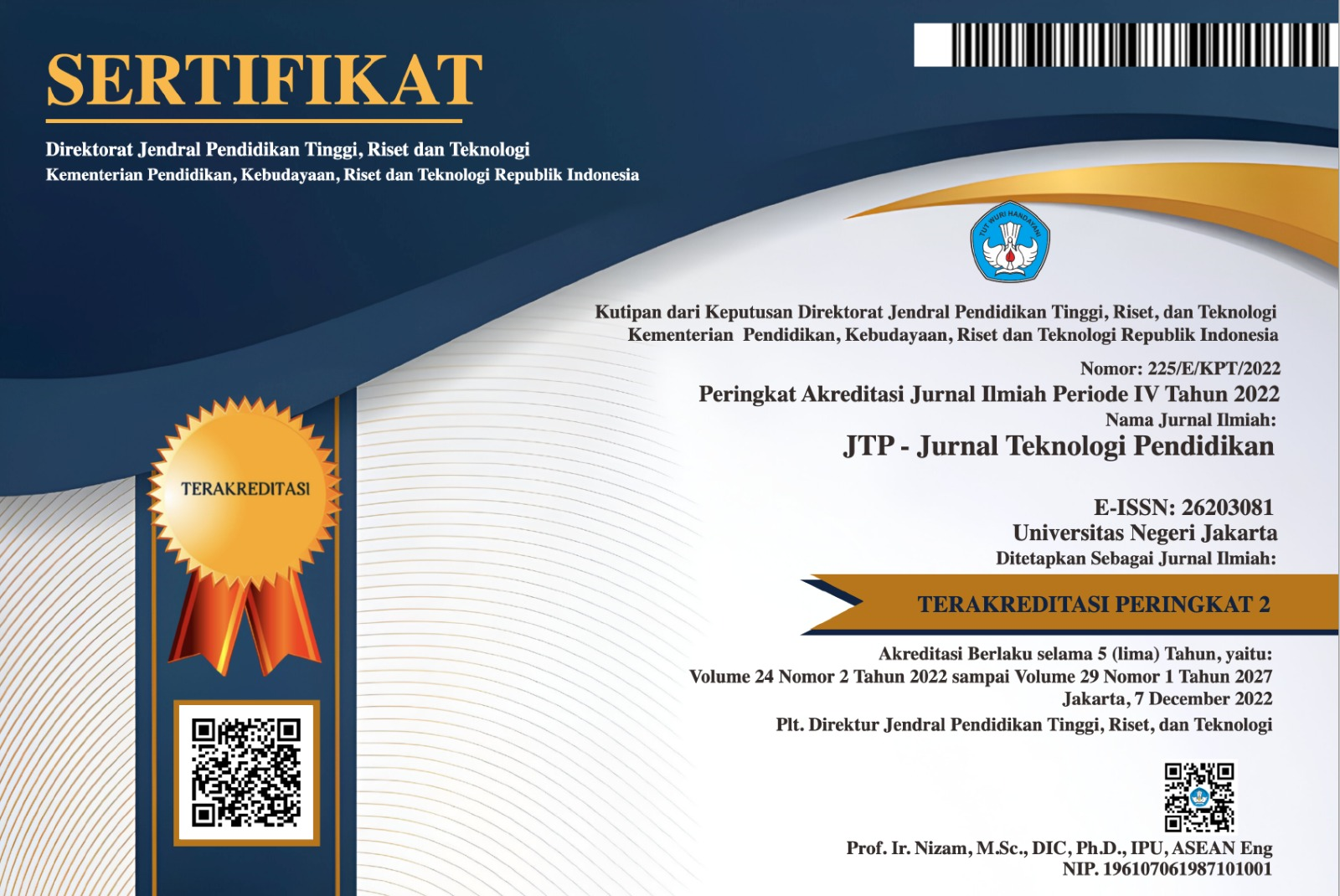Effectiveness of Blended Learning Model Development Educational Evaluation Course
DOI:
https://doi.org/10.21009/jtp.v25i2.34911Keywords:
blended learning, educational evaluation course, online learningAbstract
The educational evaluation course is one of the courses in the undergraduate Islamic Religious Education study program. This course teaches theory and practice. The problem in this study is in the form of educational evaluation material with the characteristics of calculating and the mathematical concepts are the main learning difficulties. Educational evaluation learning outcomes have not shown maximum results. By creating a learning material product, this research aims to create a blended learning educational evaluation course and then test the product's effectiveness. The study and development method is the one that is employed. The planning, development, and evaluation phases of the Dick and Carey model are used in this research. Learning design experts, material experts, language experts, and media experts are tested as part of the product testing process. Learning design specialists received an average score of (4.46), followed by material experts (4.44), language experts (4.60), experts in print media (4.82), and experts in non-print media (4.44). (4.58). Following that, 90.91% of one-on-one trials with three pupils were very feasible, followed by 95.28% of small group trials and 96.10% of field trials. After modifications were made based on ideas and advice from experts, the product learning materials are, in conclusion, very practicable to use. The results of the effectiveness test of learning material products revealed that there is a significant difference between the pre-test and value post-test in the use of learning modelsblended learning educational evaluation subject in the learning process. The paired sample t test results obtained a p-value = 0.000, which means that the p-value 0.05. The results of the product effectiveness analysis in the form of student learning outcomes seen from the pre-test and post-test showed an increase, the pre-test total score was 334 and the post-test total score was 616. This shows that the learning outcomes have increased scores so that it can be concluded that the material blended learning in educational evaluation courses is proven to be effective in increasing learning outcomes.
References
Arikunto, S. (2016). Prosedur Penelitian. Rineka Cipta.
Davies, I. K. (1996). Educational Technology: Archetypes, Paradigms, and Models. In D. P. Ely & T. Plomp (Eds.), Classic Writings on Instructional Technology. Libraries Unlimited.
Dick, W., Carey L. & Carey, J. O. (2015). The Systemic Design of Instruction. 8th end. Pearson.
Dwiyogo, W. D. (2018). Pembelajaran Berbasis Blended Learning. Rajawali Pers.
Gagne, R. M., Wager, W. W., Golas, K. C., &, & Keller, J. M. (2005). Principles of Instructional Design (p. 1). Wadsworth Thomson Learning.
Garrison, D. R. (2011). E-learning in the 21st century: A framework for research and practice. Routledge.
Gustafson, K. L., & Branch, R. M. (1997). Survey of Instructional Development Models. Clearinghouse on Information & Technology, Syracuse University.
Hassana, Ruba Abu & Woodcock, A. (2014). Blended learning : Issues and Concerns. Coventry University: Coventry School of Art and Design.
Henson, K. T. (2015). Curriculum Planning: Integrating Multiculturilsm, Constructivism, and Education Reform (5th ed.). Waveland Press.
Marzuki, I., Syahrial, Z., & Rusmono. (2020). How to develop blended learning educational evaluation courses islamic religious education study program. Universal Journal of Educational Research, 8(3 A), 24–34. https://doi.org/10.13189/ujer.2020.081404
Morrison, G. R., Ross, S. M., &, & Kemp, J. E. (2001). Designing Effective Instruction (p. 13). Jonh Wiley & Sons, Inc.
Nirahua, J., Taihuttu, J., & Sopacua, V. (2020). Pengembangan Bahan Ajar Berbasis Blended Learning Dan Critical Thinking Skill Pada Mata Kuliah Astrofisika Dalam Menyongsong Era Revolusi Industri 4.0. Jambura Physics Journal, 2(1), 24–36. https://doi.org/10.34312/jpj.v2i1.6869
Pegler, C., & Littlejohn, A. (2007). Preparing for Blended e-Learning. Routledge.
Reigeluth, C. M., & Chellman, C. A. A. (2009). Understanding Instructional Theory. In C. M. Reigeluth & A. A. Carr Chellman (Eds.), Instructional-Design Theories and Models Volume III: Building a Common Knowledge Base. Taylor and Francis.
Siemens, G. (2006). Global summit 2006 : technology connected futures Connectivism : Learning and Knowledge Today.
Smith, P. L., & Ragan, T. J. (2009). Instructional Design (2nd ed.). Wiley.
Sukardjo, M., Uswatun Khasanah, & Fatur Rahman. (2022). Trainer Effectiveness in Basic Electrical and Electronic Practices in Vocational High Schools. JTP - Jurnal Teknologi Pendidikan, 24(3), 412–425. https://doi.org/10.21009/jtp.v24i3.33595
Susianto, D. (2014). Pengembangan Bahan Ajar Berbasis E-Learning Dengan Menggunakan Model Project Based Learning MK Pemrograman II. Jurnal Cendikia, 10(1), 1–9.
Utomo, M. R. F., & Sukisno, T. (2018). Pengembangan Bahan Ajar Mata Kuliah Praktik Pemeliharaan Dan Perbaikan Kelistrikan. 8(1), 25–31.
Watson, J. (2008). Blended Learning : The Convergence of Online and Face-to-Face Education. North American Council for Online Learning, 572, 16. https://doi.org/10.1016/j.aca.2006.05.012
Wibawa, B., Mahdiyah, & Afgani, J. (2014). Metode Penelitian Pendidikan [Educational Research Methodoly]. Universitas Terbuka.
Wintarti, A., Artiono, R., & PriyoPrawoto, B. (2019). Pengembangan Bahan Ajar BerbasisBlended Learning Pada Mata Kuliah Dasar-Dasar Matematika. Penelitian Pendidikan Matematika Dan Sains, 3(2).
Downloads
Published
How to Cite
Issue
Section
License
Jurnal Teknologi Pendidikan is an Open Access Journal. The authors who publish the manuscript in Jurnal Teknologi Pendidikan agree to the following terms.
Attribution-ShareAlike 4.0 International (CC BY-SA 4.0)
-
Attribution — You must give appropriate credit, provide a link to the license, and indicate if changes were made. You may do so in any reasonable manner, but not in any way that suggests the licensor endorses you or your use.
-
ShareAlike — If you remix, transform, or build upon the material, you must distribute your contributions under the same license as the original.
- No additional restrictions — You may not apply legal terms or technological measures that legally restrict others from doing anything the license permits.
Notices:
- You do not have to comply with the license for elements of the material in the public domain or where your use is permitted by an applicable exception or limitation.
- No warranties are given. The license may not give you all of the permissions necessary for your intended use. For example, other rights such as publicity, privacy, or moral rights may limit how you use the material.








